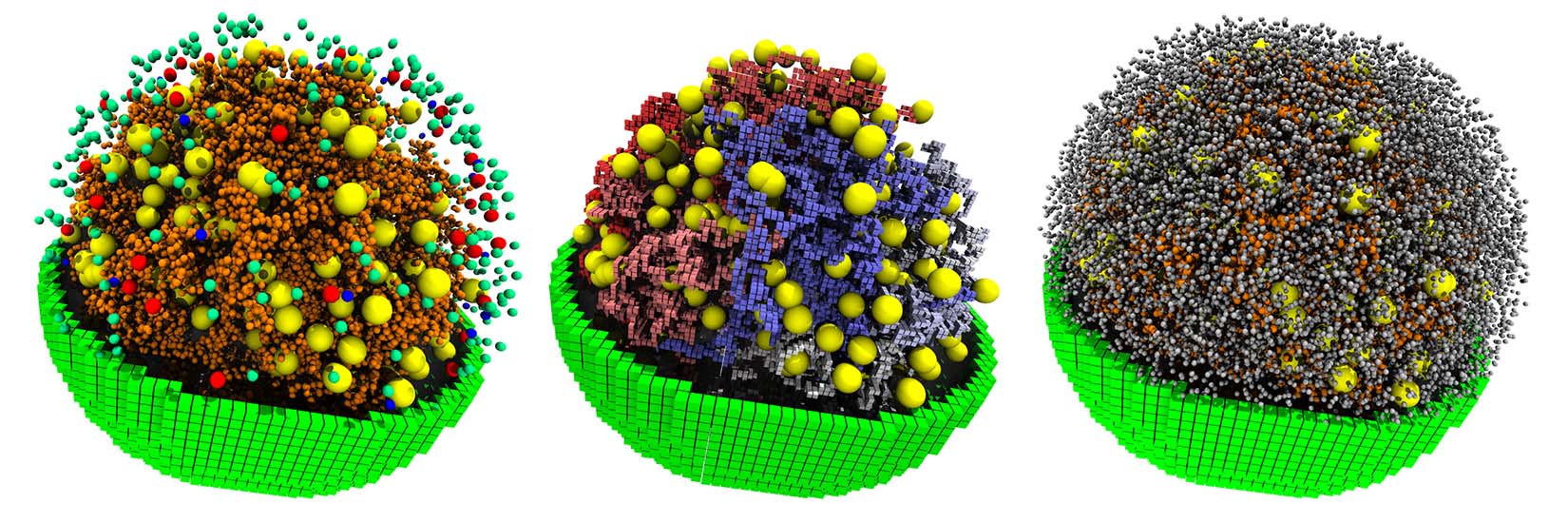Scientists develop most complete whole-cell computer simulation model of cell to date
J. Craig Venter Institute model organism-minimal cell platform provides robust tools for exploring first principles of life, design tools for genome
LA JOLLA, CA—January 20, 2022—Scientists from the University of Illinois at Urbana-Champaign, J. Craig Venter Institute, and Technische Universität Dresden have developed a computer model of the minimized synthetic cell, JCVI-syn3A, that accurately predicts the growth and molecular structure of its real-life analog. It is the most complete computer-simulated whole-cell model to date. The findings have been published in the journal Cell.
The JCVI team has been doggedly pursuing knowledge of how to construct cells using genetic code designed on a computer with the goal of understanding the first principles of life. JCVI scientists constructed the first cell with a synthetic genome (Mycoplasma mycoides JCVI-syn1.0) in 2010 and then in 2016 built a minimized cell (JCVI-syn3.0), with the smallest genome of any known cell capable of growth in laboratory media.

The computer model is based on JCVI-syn3A, a mutant of the original JCVI-syn3.0 that adds genes necessary for normal cell division. In the original 2016 publication, 149 of JCVI-syn3.0’s genes were of unknown function. This number has now been reduced to 92 out of the 493 genes which make up JCVI-syn3A.
JCVI-syn3A’s genome and physical size are approximately one-tenth those of the model bacterial organism E. coli and has a smaller fraction of genes with unclear function (92/452, 20%) than E. coli (1780/4637, 38%) and Mycoplasma pneumoniae (311/688, 45%).
“Given the reduced complexity of the genome, understanding and availability of tools for manipulating the organism, annotation of gene function, and now a robust computer model of JCVI-syn3A, it has become a model organism of significant interest. What began as a single-institution effort, JCVI-syn3.0 and JCVI-syn3A provide a robust platform for investigators and is being used by over 50 labs worldwide.,” stated JCVI Professor John Glass, Ph.D., a senior author on the research.
Professor Glass continued, “When we set out to assemble and boot up a cell with a synthetic genome and then a minimal genome it was always with an eye towards the first principles of life and being able to address one of the oldest philosophical questions of humanity: ‘What is life?’ By building a cell with fewer genes than any known naturally occurring cell we have enabled developing a correspondingly simple model where the minimal cell’s genes can inform a computer model that correctly predicts the behavior of the cell. This provides a test of our understanding of the minimal requirements for life.”
In addition to shedding light on the basic requirements of life, such a model also provides a design tool for predicting the effects of changes in the genome. For example, the computer models predicted reintroduction of two non-essential pyruvate dehydrogenase genes to the minimal cell would decrease the time between cell divisions by about 13%. This same experiment was then performed in the lab by JCVI scientist Andras Cook. When he added the genes back in the time between cell divisions reduced from 120 to 105 minutes, or 12%. Other experiments like this are in progress both to confirm the model and to help guide researchers in deciding how to add new pathways to the minimal cell.
Unlike previous whole-cell models, these simulations are based on fully dynamical kinetic models where subsystem networks and chemical species are interconnected continuously over time on a single cell basis. The reactions in the macromolecule metabolism are kinetically modeled through approximately 2000 reactions involving the 251 genes in the genetic information processes of DNA replication, transcription of all 493 genes, translation and degradation of all 452 mRNA, tRNA charging, and cell growth.
Over a cell cycle it is revealed how the cell balances demands of its metabolism, genetic information processes, and growth and offers insight into the principles of life for this minimal cell. The energy economy of each process including active transport of amino acids, nucleosides, and ions is also analyzed.
The complete study, “Fundamental Behaviors Emerge from Simulations of a Minimal Cell,” may be found in the journal Cell. The minimal cell modeling software may be downloaded from GitHub.
About J. Craig Venter Institute
The J. Craig Venter Institute (JCVI) is a not-for-profit research institute in Rockville, Maryland and La Jolla, California dedicated to the advancement of the science of genomics; the understanding of its implications for society; and communication of those results to the scientific community, the public, and policymakers. Founded by J. Craig Venter, Ph.D., the JCVI is home to approximately 150 scientists and staff with expertise in human and evolutionary biology, genetics, bioinformatics/informatics, information technology, high-throughput DNA sequencing, genomic and environmental policy research, and public education in science and science policy. The JCVI is a 501(c)(3) organization. For additional information, please visit www.JCVI.org.
Media Contact
Matthew LaPointe, [email protected], 301-795-7918